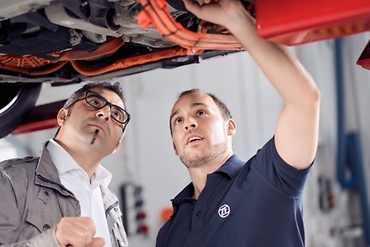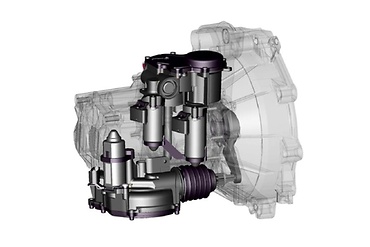
September 28, 2022
6 minutes read
Our experts proudly present
#inbrief
We are the ZF Aftermarket technical support team.
Under the hashtag #inbrief we are going to present you, on a regular basis, a new topic by illuminating it from all angles. These topics may relate to new products or frequent customer inquiries that reach our ZF Aftermarket technical support team. All information on today's topic are available for you to download here.
Do you have a specific question on any technical subject or product information?
precise in curves and corners
Staying alert when changing shock absorbers
If chassis components need to be replaced, this also includes checking and, if necessary, replacing the associated complementary products such as suspension springs, strut mounts and service kits. This is the only way to guarantee the full degree of functionality, reliability and customer satisfaction.

SACHS brand, ZF Aftermarket has a well-known manufacturer in its portfolio, equipping more than ten million new cars with their shock absorbers – every year. This is just one of the obvious advantages of the complementary products from SACHS:
• comprehensive portfolio
• utmost material quality
• tailored to SACHS spare parts – for a one-stop shop.
We will inform you briefly about the most important products, how damage and wear can be identified, and what needs to be considered when replacing:
Rubber against dirt and wear
Service kits

Service kits consist of compression buffers or auxiliary springs and bellows or protective tubes and have the following functions:
• Protecting the shock absorbers' piston rod from salt residue, water, dust and dirt
• Protecting shock absorbers and suspension springs against overload
• Reducing vibrations along with the shock absorbers and suspension springs.
Either as a compression buffer to prevent shock absorbers and suspension springs from overloading, as coming into contact with the piston rod would destroy the base valve – as a result of which the shock absorber would cease to function.
Or as an auxiliary spring to help the suspension spring and shock absorbers reduce vibrations.

Defective service kits can be diagnosed simply by visual inspection. They lead to premature wear in the shock absorbers. Piston rod damage results in shock absorber leakage.
Defective service kits also overload the suspension spring and lead to accelerated wear of the suspension-strut mounts.
Rubber-metal for a smooth ride
Suspension-strut mount

The suspension-strut mount is the upper mounting point of the shock absorber. At the same time, it supports the vehicle weight, enables steering depending on the axle design, and dampens rolling noises and vibrations.

Rubber-to-metal components are subject to high dynamic loads and often to harmful environmental influences such as heat, road salt and ozone as well.
The consequences of a defect range from increased noise generation and longer stopping distances to the loss of precision wheel guidance.
We recommend replacing the suspension-strut mounts when replacing the shock absorbers – ideally always in pairs. Ideally, all work on brakes or tires can be used to check, test and replace rubber- to-metal components.
Caution! In some cases, the installation position must be strictly adhered to!
• The installation position must be marked prior to removing the defective bearings. In some cases, the positioning marks are on the actual parts or on the installation location in order to permit the exact mounting of the new bearing.
• At all costs, avoid oil as an assembly aid for rubber-to-metal components, as oil affects rubber surfaces and destroys the component. Experts recommend using a soap solution.
• When dealing with link mounts and suspension-strut mounts, securely tighten the mounting screws with the required torque only once the vehicle is in its assembly position again. This prevents distortions in the bearing that could lead to premature wear of the new parts.
Suspension between wheels and body
Suspension springs

Suspension springs are the connecting element between the wheels and the vehicle body. They support the weight of the vehicle and, together with the shock absorbers, ensure optimal roadholding in all driving situations and under varying load conditions. Suspension springs also compensate for bumpy roads and ensure good wheel-to-road contact.
Together with dampers and suspension-strut mounts, suspension springs fulfill important safety and comfort functions. This is why you should regularly inspect the components and replace them in the event of corrosion damage or fractures.

The following image shows wear on a SACHS spring:
• Mileage: 112,000 km
• Length difference new/old spring:
> unloaded = 1.3 cm
> loaded (2000 N) = 1.7 cm
• Therefore, always replace in pairs.

Defective springs negatively affect vehicle handling and road-traffic safety:
• They extend stopping distances, as they can no longer correctly absorb the forces that occur upon deceleration.
• In addition to that, tires lose road contact more easily and wear more quickly.
• In fast or tight curves, the car has a greater tendency to move sideways and will swerve earlier.

A sacrificial anode is made of a piece of metal that is used in devices and vehicles to protect functional parts made of other metals (especially iron, steel and brass) against contact corrosion. Sacrificial anodes, also called galvanic anodes, can be found between the spring seat and the spring. They protect the spring against premature wear. Sacrificial anodes must be obtained from the vehicle manufacturer.
About the authors

The Technical Team
Our technical team for Germany, Austria and Switzerland consists of real troubleshooters: When it matters, they are there!
"Always on the technological pulse!"



